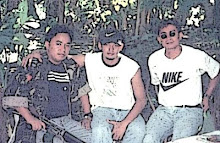
Hopes faded on Monday that more survivors would be found in what could be one of the Philippines’s worst sea tragedies as rescuers failed to find signs of life inside a capsized ferry that had held more than 800 passengers and crew members when a typhoon struck on Saturday.
Rescue officials said only 38 survivors had been rescued, including 28 passengers and crew members who came ashore Monday after drifting at sea since Saturday.
A total of 13 bodies believed to be from the ferry, Princess of the Stars, have been recovered, including nine that washed up on land on Monday.
The known dead from the ferry brought the death toll from the typhoon, named Fengshen, to at least 176, the Philippine National Red Cross said. Fengshen, packing winds of up to 121 miles per hour , struck the central and northern Philippines on Saturday, knocking down power lines, causing landslides, flooding rivers, and inundating entire communities.
Divers who beat against the hull of ferry on Monday in search of survivors heard nothing that indicated life.
“We just approached the hull of the ship, we got near and then banged, knocked in order for us to give a sign if ever there are still people inside,” Lieut. Col. Edgard Arevalo of the Coast Guard said Monday. “Unfortunately there was no response.”
The Philippine government has asked other countries, particularly the United States, for help in the recovery operations. A United States Navy ship from Okinawa, Japan, was expected to arrive early Tuesday near Sibuyan island, south of Manila, where the ferry sank, said Jesus Dureza, press secretary of President Gloria Macapagal Arroyo.
Officials said helicopters on the Navy ship could help survey the general area for possible survivors.
Eleandro Madrona, a congressman of Romblon Province where the ferry sank, flew over the area on Monday afternoon, but reported seeing only a tugboat near the ship’s wreckage.
“I was thinking, where could these 700 people be?” Mr. Madrona said, according to The Associated Press.
Elsewhere, officials tried to assess the losses from the typhoon. Iloilo, a central Philippine province, was the worst hit, with fatalities approaching 100 as of Monday, officials said. It was too early to determine damage to agriculture and infrastructure, but officials said it could run up to billions of pesos.
Another concern was the welfare of the nearly 70,000 people across the country who were displaced by the typhoon and are now living in evacuation centers. On Sunday, Ms. Arroyo ordered all government agencies to help in the relief operations, while private companies have begun campaigns to collect donations of food, clothing and bottled water.
The president also ordered tighter maritime regulations. “Pending a review of Philippine Coast Guard protocols, no vessel sails if it would pass a possible typhoon path,” Ms. Arroyo, who is on a state visit in the United States, said in a video conference with her advisers on Monday.
The government has suspended the operation of all vessels of Sulpicio Lines, which owns the 24,000-ton ferry, which was capable of carrying 1,992 people.
Distraught relatives of the ferry’s passengers have trooped to the Manila office of Sulpicio Lines since Sunday, many of them blaming the company for the disaster. An advocacy group for crime victims, Volunteers Against Crime and Corruption, announced Monday that it was filing a class action suit against the company.
Officials of Sulpicio Lines, however, said that they tried to set in motion a rescue operation as soon as they learned that the ship had encountered problems. But “severe weather condition delayed the rescue efforts both from the sea and on air,” Carlos Go, the company’s chief executive officer, said in a statement on Monday.
“Our company also assures the families of all unfortunate passengers who perished in this incident that they will be properly compensated,“ Mr. Go added.
Coast Guard officials told reporters Monday that they cleared the ferry to leave Manila for Cebu, a city in the central Philippines, on Friday night because the initial forecast for Fengshen showed it would only hit the eastern part of the country, away from the ferry’s path.
But according to the government’s weather bureau, the typhoon changed direction on Saturday, moving toward the center of the country, running right into the ferry’s path.
Coast Guard officials said they advised the ferry to seek shelter, but that the boat’s engine failed after being battered by the strong winds and waves, thus leaving it even more vulnerable to the intensifying storm.
In a television interview, Senator Richard Gordon, who is also the chairman of the Philippine National Red Cross, quoted a survivor as he described what happened next. According to the survivor, “It was high noon but it was so dark, and there was too much rain and the waves were just too much for the ship,” Mr. Gordon said.
Sulpicio Lines is one of the country’s largest shipping companies, with 22 ships, both freight and passenger, plying the major routes of the Philippine archipelago.
Its ships and ferries have figured in many of the worst maritime disasters in the Philippines. In December 1987, an overloaded Doña Paz collided with an oil tanker off Mindoro Island, killing more than 4,300 people.
A year later, in October 1988, another Sulpicio Lines ship, Doña Marilyn, sank near Leyte province, killing 300 passengers and crew. In 1998, 200 died when the Princess of the Orient, also a Sulpicio liner, capsized near Manila during a storm.
Source: nytimes.com
Tuesday, June 24, 2008
Hope Fades in search of Survivors
Labels:
Fengshen,
Princess of the Stars,
Typhoon Frank
Subscribe to:
Post Comments (Atom)






No comments:
Post a Comment